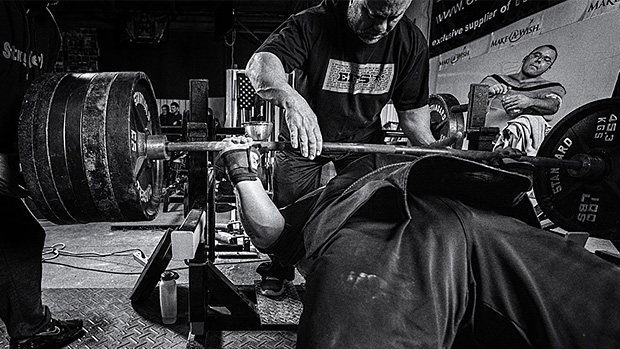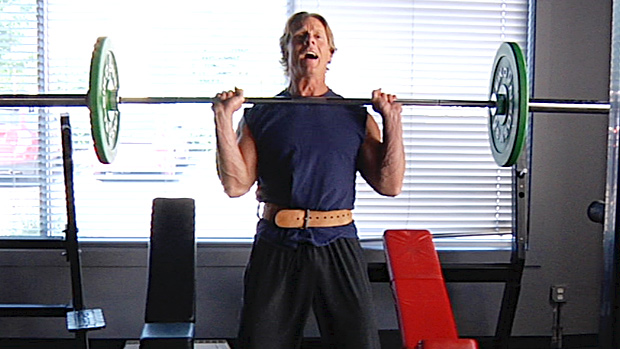You've seen the ads. "Washboard Abs While Watching TV!" Uh huh. Yeah, right. EMS, or electronic muscle stimulation, has been around for a long time. And while most people with a lick of common sense don't buy into these outrageous ads, there is a lot of curiosity about these muscle zapping gadgets
Do they have any real uses? They may be okay for rehabbing athletes, but could bodybuilders benefit from them?
"Increase your strength beyond your natural limits!"
"Twenty percent maximum strength gains in three weeks!"
"Break through training plateaus!"
Sounds too good to be true, but all this is possible with the proper use of electronic muscle stimulation (EMS). EMS has been used in former Communist Bloc countries for sport training since the early 1950s, but Western countries only became aware of its use in 1973, when Dr. Y. Kots of the Central Institute of Physical Culture in the former USSR outlined the tremendous potential for strength enhancement beyond that which was possible by traditional (voluntary) training methods.
His claims raised many eyebrows and considerable effort was expended in an attempt to validate Kots' claims. Crude studies that pitted EMS-fired muscles against voluntarily contracted muscles (using Cybex machines for measurement) appeared to show that EMS wasn't as effective as Kots had claimed. However, the design of these studies was flawed due to a poor understanding of how EMS works on the neuromuscular system.
An EMS stimulus fires all the motor neurons in the treated area simultaneously, creating an uncoordinated contraction, which is primarily isometric in nature. Voluntary muscular contractions, on the other hand, roll through the muscle in a wave to generate a coordinated, directed force.
Kots was able to show, using a tensiometric device, that the muscle tension produced in a maximal EMS contraction can be up to 30% higher than a maximal voluntary contraction. This finding was corroborated by independent studies and makes intuitive sense, given the nature of the body's energy conservation system.
Since individual muscle fibers can be completely exhausted in just a few seconds, the body has adopted several strategies to prolong endurance. Slow twitch (red) fiber is used first in voluntary contractions, as it is energy efficient, though not very powerful. Then only enough strong, but voracious, fast twitch (white) fiber is added to handle the load.
In addition, muscles work their individual fibers in relays, always holding some back from even the most demanding load to maintain a reserve. Therefore, it's impossible to voluntarily contract all fibers simultaneously. The order of recruitment makes it likely that most of the fibers held in reserve will be white.
EMS works directly on the muscles, bypassing the body's energy conservation system, thus there's no limit to the percentage of fiber that can be activated. The EMS stimulus "spills over" from fully contracted fiber to activate remaining fiber (given sufficient current) allowing the athlete to experience a training stimulus that's unattainable by any other means.
The supra-maximal nature of this exercise enhances the strength to weight ratio by favoring enhanced recruitment over cross-sectional growth and also optimizes fiber splitting and the conversion of intermediate fiber to white fiber, the "Holy Grail" of power training.
Recruitment velocity is the rate at which a muscle fiber can achieve maximum tension, varying from 20 milliseconds for white fiber to 65 milliseconds for red fiber. Recruitment rates vary since red fiber gets a "head start" in voluntary contractions as white fiber is only added in as needed once the load has been determined.
EMS reverses the natural recruitment order, as its nonspecific current flows more easily through the bigger neuron of the white fiber (less resistance) forcing red and intermediate fibers to shorten their recruitment rates in response to white fiber recruitment, which now precedes rather than follows in the contraction.
The reversed recruitment order combined with the positive effects of high intensity make EMS ideal for improving recruitment velocity across all fiber types, a key factor in explosive events.
The benefits of EMS have been discussed extensively in theory but the real challenge is the successful incorporation of EMS into a training program. There are four main uses for EMS in sport training. First, for the enhancement of maximum strength; second, as a means of recovery; third, as a rehabilitation tool; and fourth, as a motor learning and muscle recruitment tool.
EMS is the single most intense strength building method and has the briefest improvement period of all training modalities. Kots' literature describes a maximum strength gain plateau after twenty-five treatments (which could be administered over four to seven weeks); however, in my experience, most of the benefits available were achieved within ten treatments and strength gains beyond fifteen treatments were negligible. And since ten to fifteen treatments maximize recruitment velocity, it seems logical to work between these numbers.
Strength is the foundation for sport-specific tasks, therefore it must be established early, in both general and specific terms. Generally, strength improvement needs are very high in the early stages of a career and diminish through the years until the athlete fulfills his strength requirements and merely must maintain them (keep in mind that this point applies to non-strength training athletes).
Strength gains on the order of 25% per year, or even higher, may be required in the first few years, though the requirement drops rapidly until top international athletes factor in improvements of 6% per year or less. This leads to the question: why don't athletes continue to push their strength work to the limit throughout their careers?
High intensity training elements must compete for central nervous system energy. A novice sprinter can't tax the CNS significantly no matter how hard he tries, but as he improves, the CNS demand rises exponentially, even if the volume of sprinting remains constant. Therefore, the degree of intensification of other factors must be reduced over time if speed is to improve further.
As a result, EMS should be used for strength development as soon as fitness fundamentals are in place, with a diminishing role in routine strength enhancement as the career advances. A quadrennial plan for a top sprinter might include EMS strength building twice per year during years one and two, reducing to once during year three and only if needed in year four.
Special strength requirements, such as secondary hip extension by the hamstring, must be in place early to facilitate the correct technique needed for the development of top speed. These special strengths can be developed even before the athlete is fast enough or skilled enough to develop them through voluntary means. EMS also facilitates the optimal fiber-type ratio, which should be in place early to aid in performance over time.
EMS strength training should coincide with maximal strength weight lifting. The two modalities are synergistic, though the introduction of EMS must be phased in to allow a smooth progression of the workload. Modern sprint training uses a triple-periodized annual plan, with three maximum strength phases, though only the first two include EMS. The third maximum strength phase is shorter, with a more moderate strength improvement goal.
In our case, the first two maximum strength weightlifting phases lasted seven weeks with a "313" loading system, that is, three weeks of high intensity lifting, followed by one week of medium intensity, followed by another three weeks of high intensity lifting to maximize adaptation.
Apply EMS work during the second and third weeks of each three week high intensity block. As our speed work, followed by lifting, occurred on Monday, Wednesday, and Friday, with speed endurance work on Saturday (Tuesday and Thursday were reserved for low intensity work, with Sunday off), we used EMS on Monday, Wednesday, and Friday, which gave us a total of twelve EMS sessions during the whole max strength phase.
This sequence allowed for the optimal number of EMS sessions in the phase with optimal recovery. (EMS doesn't require 48 hours for recovery, as it bypasses the central nervous system; however, this schedule optimized the recovery for the other training elements). The volume of explosive power and sprint work must increase seven to ten days after completion of the max strength/EMS phase for the optimal incorporation of the new abilities and to compensate for the drop in CNS stress.
When adding EMS to a program, expect your peak performance up to two weeks later than before, as you're now tapering from a much higher workload.
Maximum strength EMS is applied to the quads, hamstrings, glutes, and the erector spinae. These muscle groups play the main role in power development around the hip joint, where, at maximum speed, the power output is seven times higher than around any other joint. The abs play a major role also, and they can be treated as well, but their rotational movement and primary support, rather than power role, favor traditional high rep training. More on this later. The soles of the feet can even be treated in cases of insufficient foot strength.
EMS works best as the last training element of the day, separated from other work by at least two hours. This is usually done at night before bed, as it can be done at home and the supra-maximal stimulus it provides is excellent for promoting the release of growth hormone during sleep.
Use a hot shower as warm up preparation, being careful to remove any oils or creams from the areas to be treated to ensure proper conductivity (oils left on the skin can cause the current to jump around the skin surface causing considerable discomfort). The increased blood flow in the muscles after the shower heats the muscle motor neurons, lowers electrical resistance, and makes them more receptive to EMS.
Start the EMS session with a gentle pulsing mode for three to five minutes to complete the warm-up before starting the maximal contractions. Warm down using the same pulsing method.
Each muscle group is stimulated maximally for ten reps of ten seconds duration with a fifty second rest period between contractions. It's critical to maintain the rest periods as prescribed as this is the absolute minimum recovery time needed to maintain a maximal contraction on the next rep. A shortened rest period may, in fact, change the nature of the exercise so that it enhances the wrong fiber type.
Sprinters use the full ten second contraction time, though shot putters and linemen find that six seconds is about the longest they can maintain a maximal contraction. In either case, the same fifty second rest period must be maintained.
Though modern stim equipment allows for a number of muscle groups to be stimulated simultaneously, never work more than two muscle groups at a time. The athlete must be able to determine where the stimulus is coming from. Keep the limbs straight and unsecured. Never stimulate antagonists at the same time for safety reasons. This also allows the athlete to concentrate on the contraction in isolation for learning reasons.
When stimulating the soles of the feet, have the athlete stand on the pads to prevent cramping. The athlete must always control the intensity of the contraction as the amount of current necessary for a maximal contraction varies widely between individuals depending on fiber type, fat distribution (fat is an insulator), muscle size, and injury history.
As a rule, sprinters require much less current to achieve a maximal contraction because their higher percentage of white fiber provides less resistance. The better the sprinter, the more this is so. EMS units have a "rise-time" feature (the time it takes to ramp up the contraction from zero to max) that is either preset or adjustable. Where it's adjustable, choose the shortest time the athlete can tolerate, usually half to three-fourths of a second.
Most users never come near the level of contraction they need for best results, especially in clinical settings. To understand the intensity the athlete needs to experience, have him contract the quads as hard as he possibly can voluntarily, and then have him imagine a goal 30% higher than that! The contraction is massive, and it feels that way! Don't worry about "burning" the muscle though, as it takes only five-millionths of an amp to maximally contract the quad.
To give you an example of what I mean by cranking it up, my athletes would often have to bite down on a piece of leather or a stick while being "stimmed." Is it really that painful? Well, it should feel like riding up a very steep and long hill on a bike. That's the type of "burn" you should feel.
Most EMS machines come with a series of electrode pads secured by Velcro straps. This is a very cumbersome and time-consuming arrangement that can be greatly improved with the purchase of after-market adhesive pads. 3M makes good ones. Choose pads that are four inches square and be sure to replace them when they lose their stickiness. (Really hairy guys may need to use contact gel with a traditional pad.)
When choosing pad placements, a lot of experimentation will be needed to find the most comfortable and effective setup, though four pads per large muscle group usually helps. Since the EMS contraction is always strongest around the negative pole, you should place the negative pad over the largest bulk of the muscle to keep the contraction even throughout the muscle.
When treating the quad muscles, keep the pads towards the outside part of the upper quads to keep the current from jumping over into the groin area unexpectedly. In a four pad setup, crossing the pairs of leads in an "X" pattern may help ensure a tolerable, but complete contraction.
The search for ever greater specificity, compounded by a basic misunderstanding of exercise itself, has driven athletes away from low intensity work, much to their detriment. For decades, exercise programs have been based on the false premise that exercise doesn't count unless it's carried out at 70% of maximum voluntary contractile force or lasts at least twenty minutes, the threshold for protealysis (the breakdown of proteins in the muscle).
Once considered to be the precursor of muscular development, it's now known to be a side effect to be avoided if possible. In fact, steroids eliminate proteolysis and no one would suggest that steroids limit muscular growth!
Low intensity exercise has a positive effect not only on recovery from high intensity work but on the high intensity work itself. While high intensity exercise is anti- circulatory as it pumps up the muscles (restricting blood flow), low intensity exercise promotes circulation, which aids in nutrient transfer and hastens recovery.
Exercise of a low enough intensity will not lead to detrimental fiber type changes! In fact, the enhanced capillary density it creates leads to precisely the opposite effect! The enhanced capillary density raises the temperature around the motor neurons, lowering electrical resistance, allowing more fiber to take on the characteristics of fast-twitch fiber in response to high intensity work.
EMS used in a pulsing mode for ten to twenty minutes at very low intensity assists with recovery by stimulating circulation and the exercise it provides promotes capillary density. The effects can be enhanced if the legs are slightly elevated during treatment. These sessions can be carried out at the end of the day, before bed, at least two hours after your last workout.
EMS can play a role in the rehab of a variety of injuries and is used extensively in clinics to treat the VMO with knee cases. But its value in the rehab of hamstring injuries is poorly understood and under appreciated.
The selection of isokenetic machines over EMS contributes to a lengthening of injury downtime as the fluid resistance on which these machines rely hits the muscle all at once, causing muscle shortening and irritation. Often, effective treatment including EMS can have the athlete back in action within ten days.
Immediately after the injury, with the leg in its normal straight position, run your hand along the hamstring to feel for a depression in the muscle to determine if there's been actual fiber separation (a third degree tear). In all but severe cases this won't have happened, meaning it's a first or second degree strain where a quick recovery can be expected.
This must be checked before swelling sets in and fills up any depression and afterwards the muscle should be wrapped, iced, and elevated in the usual fashion. Do not test or stretch the muscle, as further damage could occur and, regardless of the findings, the initial treatment remains the same. Surprisingly, it usually takes only 72 hours for the injury to heal, but extension injuries can occur above and below the original site and adhesions can form if the tissue isn't mobilized sufficiently.
During the initial 72 hours, the athlete should stay off his feet as much as possible and an EMS pulsing mode can be applied above (not on) the injury site three to four times per day to reduce swelling and promote the transfer of nutrients to the site. After 72 hours, very gentle EMS pulsing can be applied to the injury site once per day while retaining the pulsing routine four times per day above the site.
From the third day on, high intensity EMS can be applied to all other muscles to maintain fitness during the recovery period. Additional therapy should include Active Release Technique (ART) if possible, to further reduce the prospect of adhesions.
Yes, EMS does have its cosmetic uses. Much like high intensity weight training, EMS increases muscular density or "hardness". Think of Ben Johnson. If you slapped him on the back you'd think you were hitting a brick wall. Although he had a great physique, he wasn't "puffy" like Arnold; he was as hard as a rock. So the thing to think about with EMS is density, not size. Think of it as maximal strength training and not hypertrophy training.
Also keep in mind that EMS is for large muscle groups only. Although an expert might be able to pull it off, the average user will not be able to use it on small muscle groups like the biceps, triceps and calves. These muscles will "roll up" on you, plus even if you could do it (like by placing your foot in a ski boot for calves) it would be excruciating.
Bodybuilders could also use EMS to help them break through a barrier. For example, if a guy's upper body is weak as compared to his legs, he could use EMS to maintain his legs for a few weeks while focusing on upper body training. Basically, he'd be allowing all his body's recovery mechanisms and central nervous system to focus on his upper body. He wouldn't lose any size in his legs and may even see some improvement in density during this time of upper body specialization.
Here's another trick that may help competitive bodybuilders. EMS can be used to temporarily "burn off" a layer of fat in small areas. What happens is that about two millimeters of subcutaneous fat is mobilized in the area directly under the pads. You can compare this to the effect seen when shooting growth hormone, i.e., there's local mobilization of the fat at the point of injection.
Now, since that layer of fat is a protective mechanism, this isn't permanent. In fact, the effect doesn't last long at all. Once the area under the pad starts to cool, the fat starts storing again. So if you're already very lean and are competing in a bodybuilding show, you'd have to use the machine (possibly even backstage) and then cover up and keep warm until you hit the stage.

Are the machines in the muscle magazine ads powerful enough? Most are. This is because they're designed for fat, non-athletes. It takes power to get through all that fat, after all. For an athlete who has a lot of white fiber (which conducts better) and very little fat, most machines are fine in terms of power. The machines we used with athletes were converted Slender Tone machines that were originally designed for fat women!
When looking for a machine there are a few things to keep in mind. First, I've seen good ones for as little as $280 as well as over a thousand. Some of them only allow you to use two seconds on/two seconds off pulses and rest periods. You don't want that (although that's fine for abs since abs should be trained as endurance fibers for ten to fifteen minutes at a time). Instead, look for a machine that allows you to control the rest periods. You'll want to be able to get ten second contractions with fifty second rest periods.
The price may also affect the comfort level of the machine, though this isn't always the case. More expensive machines may be more comfortable to use. A machine with higher hertz is usually more comfortable and better for sprinters, but the battery life will be very short. A low hertz machine has better battery life. Lastly, look for quality in the leads and pads.
No, EMS will not give you Arnold's biceps while sitting on the couch, but as you can see, it does have many uses in athletics, rehabilitation, and even for bodybuilding. Just remember, crank it up!





